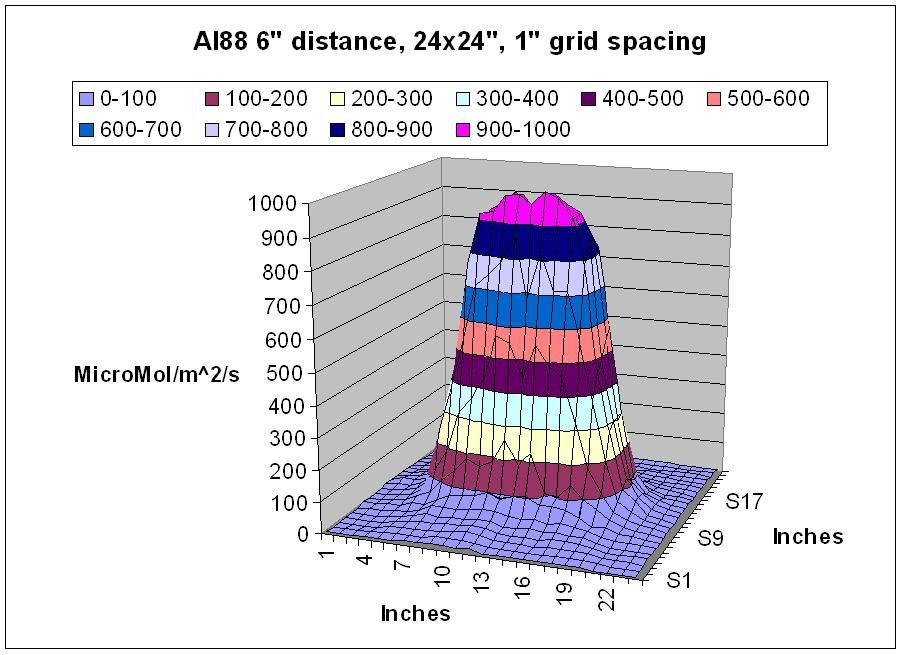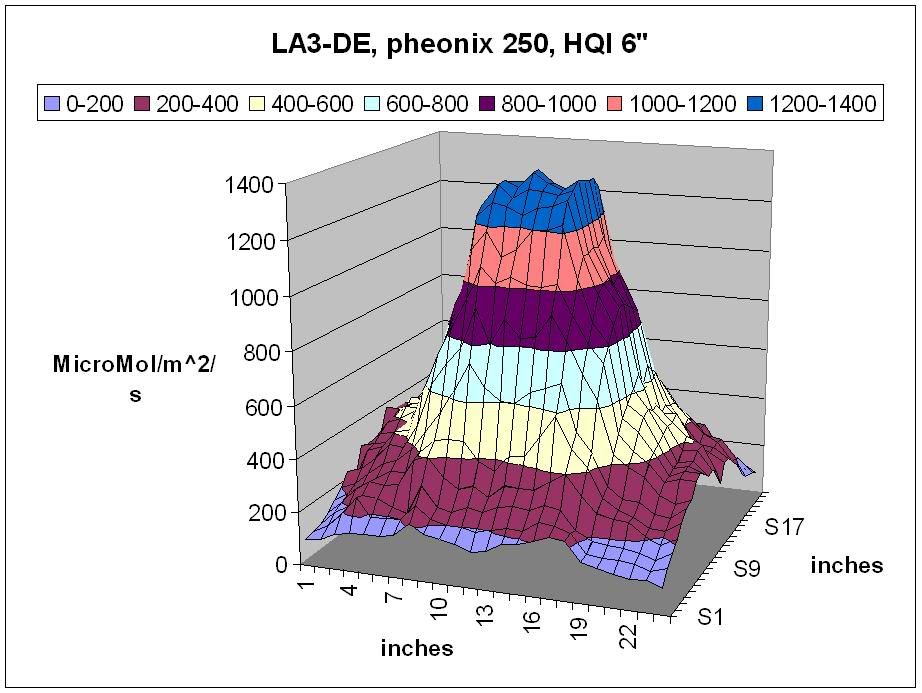

|
|
|
#526
|
|||
|
|||
|
Quote:
We'll be awaiting your performance analysis. |
|
#527
|
|||
|
|||
|
Shortly. I have finished taking all the measurements. I skipped the 30" distance though... the 6", 12", 18" and 24" pretty much spell everything out. Besides, its not like taking these numbers means much for final/real world values because of how the water surface augments the light rays. If anything, it shows if and how a reflector converges (hot spots), diverges (lack of hot spots all together) , or achieves parallel rays (best penetration and even intensity). But with LED's, these things arent as important... you have many tiny light sources that come together and have very focused outputs, you know? There is little in the way of convergence or divergence even possible (unless you were to start mounting the LED's on angles).
Soon... very soon. I just have to remember how to use excell to make those funky little graphs like Sanjay and Dana...lol.
__________________
"If at first, the idea is not absurd, then there is no hope for it" -Al Einstein |
|
#528
|
|||
|
|||
|
Your cost analysis was succinct and actually conservative. Another comparison would be to match the Aquaillumination against the Sfiligoi ACLS.
Hope you have fun testing the lighting. It looks as if you received enough toys this Xmas to keep you busy. |
|
#529
|
|||
|
|||
|
One thing that hasn't been mentioned much is the possibility of color shift, and/or damage to the LED''s from heat. Do the manufacturers of these systems provide coverage in the current warranties to cover such issues?
I would also be curious to see some temps on the junctions, as that is a key to determining LED longevity the most. Secondly, running most of the newer LEDs at their highest rated current is detrimental to longevity. |
|
#530
|
|||
|
|||
|
Badpacket - I don't remember if it was this thread but AI has said thier Tj is ~ 40C. I have not seen any data on the Lumiled Rebels the PFO I4 uses or the K2 the H4 uses. From the Seoul Semi website( AI uses Seoul Semi LEDs which are Cree die with Seoul's phosphor and package) you'll be able to get the QA doc which has the color shifts and longevity by Tj. I don't have time tonight but I posted it earlier. At 40C it looks good.
I doubt you'll see warranty coverage because it all depends on how the heat is removed from the unit. If the user puts it in a hot room or inside a canopy that allows higher Tj then how can that be covered. The manufacturer has no control. |
|
#531
|
|||
|
|||
|
I had 3 LED's go out on my H series 3 months in to running it. I called Carla at PFO because my Solaris has a 2 year warranty. She is shipping me a new 5 light LED strip to replace it. PFO made good with there warranty.
__________________
Way too busy posting... |
|
#532
|
|||
|
|||
|
Quote:
with that stated I am using the rebel star to make a light which I am going to offer as a dyi write up the Tj temperature for a rebel according to the tech rep at luxeon is 120C max with no degradation up to 100C at which point the led cluster degrades almost at a log10 rate you can use them above 100C but not for long. with the heat sink I am using a 14 x 5 inch section with 12 clusters attached the Tj temperature is running 20C higher then ambient measured by placing a micro Thermistor right at the center of the led and the heatsink plate then extrapolating using the formula given by luxeon, so in a 25c room the Tj is only 45C well under the 100C limit without damage or degradation even in a hooded enclosure where the temperatures can hit 65C you are still at 85C which is still under the 100C limit and this is done without active cooling (no fan) the numbers get a lot better when even the smallest amount of air is ran over the heatsink. the leds were ran at .88 amps and 13.6 volts per cluster and controller circuit hahnmeister thank you for your previous input, about the circuit being a little complicated for the average user I have made PCB with full silk screen legends I tested them out on some 5 - 8 year olds to see if they could put the components in the right places (nice to have all the nieces and nephews over for Christmas) and they did a great job (now if I could just get them to learn how to solder..lol) thanks for the input it does make a very neat and easy assembly process while taking the "intimidation" out of it. |
|
#533
|
|||
|
|||
|
Hi divernm:
A couple clarifications: Quote:
Quote:
BR, -Chris |
|
#534
|
|||
|
|||
|
Quote:
thank you for the quick response and correction, I was under the misconception that the I3 was the older version and uses the luxeon III and that the H4 was the newer version and as Philwd and yourself state uses the K2, thank you for the clarification. do you know what collimator lens they are using for the rebel and why use it when the rebel light throw is already in at the right angles. |
|
#535
|
|||
|
|||
|
killagoby - I should have explained better. Probably shouldn't be making technical replies at 1:30 in the morning.
Badpacket was asking about color shifts due to high junction temp. PFO warranty I believe is 2 years. But the LEDs are rated at 50000 hours; much longer than 2 years at normal use. I believe most users would not see appreciable color shifting within the normal warranty period. I was thinking about specific warranties for the issues badpacket mentioned which are not the usual ones you hear discussed. And would only become apparent some time past the usual warranty. In that situation I do not see any additional warranty being made. I am glad to hear PFO is making good on replacing bad LEDs. Kind of worried you had to take advantage of the warranty at all. |
|
#536
|
|||
|
|||
|
So how are the AI Seoul Semi LED's that AI uses SUPPOSED to stack up against the K2's?
__________________
"If at first, the idea is not absurd, then there is no hope for it" -Al Einstein |
|
#537
|
|||
|
|||
|
White (6500K): Luxeon K2 w/TFFC (PN: LXK2-PWC4-0200) should produce ~200 lumens @ 1A and the Seoul Semiconductor P4 series (PN: W42180-U) should be ~240 lumens @ 1A.
Blue: Luxeon K2 (PN: LXK2-PB14-Q00) should produce ~35 lumens @ 1A and the Seoul Semiconductor P4 series (PN: B42180) should be ~52.8 lumens @ 1A. These numbers are taken off the respective manufacturer's website and are the highest output parts of each of the series. -Chris Quote:
|
|
#538
|
|||
|
|||
|
divernm - sounds like a cool dyi. 20C above ambient would be pretty good. I would love to see the degradation curves for the Rebels by Tj. I doubt there's no degradation just that it hasn't reached some spec limit. I haven't looked real hard for the Rebel data. Maybe something to do while I'm off for the holidays. I'm just eagerly waiting on Hahn's results.
|
|
#539
|
|||
|
|||
|
Quote:
lol
__________________
Way too busy posting... |
|
#540
|
|||
|
|||
|
Hahnmeister,
If you have data, please publish. If you want to graph, great, but don't let that keep you from making the data available. Please post as soon as you have the data available. Thanks again for performing tests. - JSM
__________________
JSM |
|
#541
|
|||
|
|||
|
Well, Im finishing up collecting data for the pheonix/HQI/Lumanarc DE combo to compare. Just give me another day or so here and I can put it all up.
__________________
"If at first, the idea is not absurd, then there is no hope for it" -Al Einstein |
|
#542
|
|||
|
|||
|
Philwd, thanks for the reply. There are a number of technical issues which need to be thought of before anyone can slap one of these together. On the plus side, the manf's have done all the homework for us. Not sure if I was looking at the Lux or Seoul datasheets, however they had some excellent heat sink data and guidelines for determining thermal load. Both for single leds and multiples.
Considering my limited knowledge about leds, I'm thinking that an diy assembly is quite doable by a number of folks on RC. The leds are available. Led drivers are available, which I believe handle all of the constant current circuitry. Thermal management is much easier as most of the data has been done already for multi-unit placement. The built-in slug also saves a lot. All in all, get an avr or pic with RTC and pwm for sunrise/set/lunar/cloud cycling, and you most of the way there. From the current interest in LEDs, I'd expect to see per unit costs start dropping as production continues to ramp up, and capacitybeing brought online. Would not be surprised to see the current mid-range hipo led pricing drop 25-40% by middle of '08. |
|
#543
|
|||
|
|||
|
Badpacket.... my Atmega128 is doing real time Sunrise/sunset and lunar calcs for any location on the planet. It can schedule half a dozen relays and PWM channels for on/off and dimming. It has been a fun project... but is a lot more complex than I first anticipated. I have moved WAY PAST "a few lines of code".
|
|
#544
|
|||
|
|||
|
the problem with these coming down in cost via ramping up production, is that the consumer will be thorouoghly unaware of what the risks are with lower quality LED arrays. We have seen several on RC experimenting with DIY fixtures, and their results have shown that lower quality LEDs can indeed be very short-lived.
__________________
Jonathan--DIBS Breeder and Card carrying member of the Square Skimmer Brigade (Click on the Red House to see my pics garage) |
|
#545
|
|||
|
|||
|
Bean, hey never said one couldn't make it as complex as one wants. However, one could make it programmable for sunrise/set with fade, etc in a minimal amount of code. We'll see where I get when I start banging on my Dragon later this month.
Really though, I on't be surprised when someone starts shipping cheaper $500 units from China in '08 that uses little more than some resistors, and a $0.50 ATTiny. Quote:
|
|
#546
|
|||
|
|||
|
True, but then people still be Skilter's these days as well....
I think at the best, even if you had units coming down to $500, you'd get a fair number of people doing just a bit more due diligence than they do with a $15-25 thingamabob. |
|
#547
|
|||
|
|||
|
Ohh I don't doubt that prices will come down... or that many folks have the skills to program the micros to add features. I was just commenting on the AVR

|
|
#548
|
|||
|
|||
|
Hahnmeister,
Happy New Year. What happened to your test data? Your last post sounded like you were just about to post it up. Hope you are okay.
__________________
JSM |
|
#549
|
|||
|
|||
 I am still relearning how to do some things in Excel... its been a while. For instance, how to change the labels for the y axis from S# to regular numbers, and how to have the spreadsheet calculate the sum of all the numbers on the grid, or a portion of the grid. Stuff like that. All the numbers are collected and put into excel in spreadsheets... just have to work out the kinks. When I post EVERYTHING, I also want to include comments about the method, actual photos, and some other important notes (like even though the LED may be more efficient than the new PFO units, I dont think the reflector system is as effective). So that will take some time. If anyone wants to walk me through the little muddy details, let me know. I bet the woman knows (she uses excel all the time unlike me), but I havent had the chance to sit her down and ask with the holidays and all.
__________________
"If at first, the idea is not absurd, then there is no hope for it" -Al Einstein |
|
#550
|
|||
|
|||
 In case you think they look similar... look at the numbers.
__________________
"If at first, the idea is not absurd, then there is no hope for it" -Al Einstein |
|
|